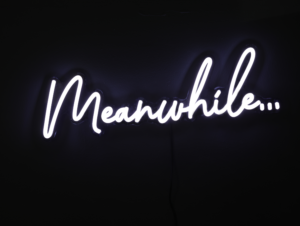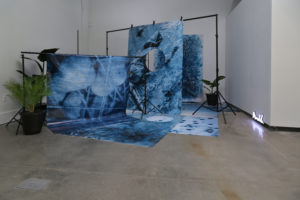Anita Allyn, Monument to an Ecosystem – Interior, 2021
Photographs: George W Chevalier
Q & A with Anita Allyn
Gallery director Margaret Pezalla-Granlund interviewed Anita Allyn about her work in February 2021. Allyn’s work is included in the 2021 TCNJ faculty and staff exhibition, Envision Us.
Margaret Pezalla-Granlund: I have like three kinds of basic questions that have been asking everyone that, you know, varies a little bit. So I wanted to start out by just asking you about your work that’s in the show, can you tell me about it, what do you have in the exhibition, where’d it come from, what’s going on with all of that?
Anita Allyn: Sure. It is originally a piece or pieces that were created to be seen outdoors to be seen actually on at a site-specific location in the woods, which is where I shot, most of the actual imagery. And so the original piece is to be experienced really differently. I was really excited, though, to think about how to experience these large banners in interior space in a way that could be a little bit more intimate. The way they were installed In an outdoor space was in a wooded area. So that, it was kind of a clearing and a dip in the landscape, where you could be walking on a path and then look to your left and see this kind of opening that you could go down and look at, but you could also get a long distance from these final murals but now they’re all together and installed in a very small space, and I think have a very different and, to me very exciting feel.
MP: Yeah I did wonder, was the neon text part of the original installation in the woods, or is it just for the gallery?
AA: It was just for the gallery. That neon came, I think, as a result of being sequestered inside for so long, it came out of that.
MP: Yeah and seeing it in the gallery was interesting because I feel like I had known that it had been in the Wissahickon originally in that it came from this site in the woods right? And once you look at it more closely, you realize that it really feels like, you can tell a little bit of that history right like it’s you know, on this heavyweight vinyl; it’s a little bit scuffed and stuff from being outside. So I like that it has this new site now inside. I also imagine the sense of scale must be very different inside than it was in the woods.
AA: Absolutely, I think, in the woods, because it was suspended in trees, it was rather grand. So in relation to your body, you could see it from a distance but then also get close to it. It’s five foot by seven foot, so for the vertical pieces, it does have a relationship, the body that’s really changed in the interior space. Where it now is mostly horizontal and that change to scale… I guess it feels more domesticated or more in control because it was exposed to the elements, as you mentioned, you can see where it’s had a busy external life among all the elements and now, it feels very, very clean but I’m glad that you can see some of the history, or the implied history.
MP: Yeah and I also like that contrast between the banners, the giant prints, and the plants that have gone into space because the plants are very pristine and very perfect. So that reference to something domesticated or controlled or kind of managed is a really nice contrast as well.
AA: Right and it was a really different kind of viewing experience, where, when you would come up upon the vinyl banners in the woods because there are holes cut through them, they have cut about 22-inch size holes that allows you to see through so you could see the banner, but then you could also see through to nature and have this interesting relationship that you experience and that’s very different now, in the interior whereas you said, there’s this relationship to the artificial landscape. The holes that I always thought of as portals when they were exterior, now just function in kind of a designed way where you can see through to another vinyl work and it becomes almost like pure pattern.
MP: Yeah, I wonder if you can talk a little bit about your process of making them. Yeah, I think that would be really interesting to hear about as well.
AA: The process was so much fun and so hard kind of simultaneously. It required that I did so many tests, so I took digital shots of different areas in the park, and I would say, probably for maybe four or five months I was wrestling with what kind of imagery I thought would be most compelling in that setting and the whole thing originated as a project to ask a question of: How can you have something in the natural landscape that would be as compelling to look at as the natural landscape if you were going to put a public artwork up.
I was really trying to wrestle with that and with the digital images, I then converted those into digital negatives, and the digital negatives, I used to make cyanotypes which is a kind of laborious process where you use the sun, as your exposure and a chemistry compound, where you coat paper and sometimes I coated fabric and sandwich the negative and the fabric together and take it outside to be exposed bring it back inside and rinse it off. It probably took me a month to even get the negative created properly. There’s this whole subculture of you know, the best exposure levels for what a black and white negative from a cyanotype look like there’s a huge rabbit hole there that I went down but after making the cyanotypes, I then rephotographed them and output the work so that they would get printed on vinyl that would be durable for a year installation outside and they’re double-sided printed and grommeted and the process was fascinating in the scale of it, I think it was the biggest scale that I worked in.
MP: Yeah and I love that you’re going between digital and this very, very analog process and then back to digital again and then like the whole fabrication aspect is like a whole other kind of way of making an image right?
AA: Right and it was much more time-consuming and it slowed me down a lot. I think that was really good for the work. I think it’s so easy with digital to be so fast and to take digital and then make it analog was really good for me in looking and thinking about what shapes and what kind of imagery I wanted to work with.
MP: Cool, yeah well, I know that you’re kind of wrapping up this really huge project, I’m wondering, what’s next? Like what are you thinking you want to try next? Are you leading to some new project, are you going off in a completely different direction?
AA: I’m really, really interested in pursuing simultaneous work that’s both exterior and more public art venue and also accessible and either showing in galleries or shown online, but I think having both of those experiences is really satisfying. I’m finding myself to be in a really rich terrain and I think there’s something really compelling about, again, the scale, so I don’t have specifics, yet, but I’m really committed to seeing what can happen with those two kinds of polls.
MP: Great, yeah that sounds exciting and I’m glad we were able to bring this into the gallery and it’s been fascinating to see like how you’ve gone from working in like sort of the anti-gallery space, like the space of the woods and then thinking about how that work can also live, you know, in a much smaller, much more specific kind of space of the galleries. I’m glad we get to see it come onto campus and on to the online exhibition as well, which is probably where most people will see it.
AA: Yeah I really appreciate the opportunity to show it, in a physical gallery space, so thank you.
MP: Well, is there anything else you want us to know about your piece or anything we missed?
AA: I think that hit a lot of really important points to me, I think exploring how to make photography both kind of public experience, as well as a more private viewing experience I’m really intrigued by then, what that’s like. You know, not going to the gallery, but then experiencing the work via screen, so I really appreciate the opportunity to do all of it.
MP: This is maybe completely unrelated to what your intention for the work was, but when I see the images kind of draped in the gallery, they look almost blanket like. There’s also something like a little bit of fuzziness to the images and there are these really beautiful blues. And it just feels like people talk about forest bathing right like that there’s this experience of being out in the woods and like having this feeling from being outside and it seems like those images bring that inside in a really different way right that they feel like sort of forest blankets, that you can bring inside with you, so I love having them in the gallery.
AA: That’s lovely! That just gave me a whole other generation of ideas of like: Okay, what if they’re printed on fur or other kinds of material so, thank you!




